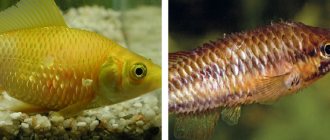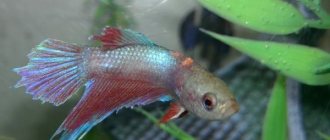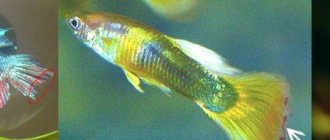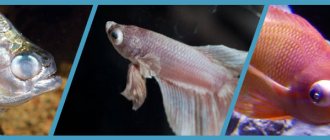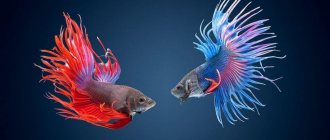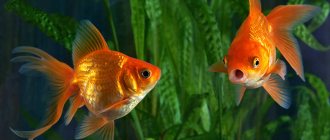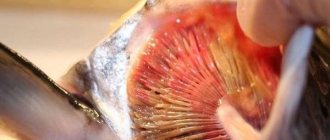A characteristic symptom of ascites is bloating, so if the veterinarian has diagnosed abdominal bloating, then there is no doubt that the fish suffers from ascites. But this is far from the only symptom that defines the disease. Eg, scales in fish it rises slightly due to the tension of the skin, which makes it look like a pine cone. How it develops ascites in aquarium fish and what to do when the first signs of the disease appear - all this will be discussed in this article.
Ascites in aquarium fish
Description of the disease
Ascites or, as it is also called, dropsy , is a common disease in fish, accompanied by bloating of the abdominal cavity. Upon visual inspection, it seems as if the sick fish is pumped up from the inside with water (hence the name). Various factors can provoke dropsy, starting with metabolic disorders and ending with the development of a bacterial infection in the kidneys.
It is not difficult to identify dropsy in an aquarium fish.
Note! When metabolism is disrupted, fluid begins to accumulate in the fish’s body, causing the abdominal cavity to swell.
Characteristic symptoms
As noted earlier, the main symptom of ascites is bloating . The disease is quite dangerous, so if appropriate measures are not taken when the first signs appear, death is possible. But if bloating can also occur with other pathologies, then to diagnose ascites you need to pay attention to other signs.
Dropsy in fish
Among the accompanying symptoms of dropsy in aquarium fish, the following are worth highlighting:
- change in skin color (fish affected by ascites gradually lose their color);
- decreased activity;
- the movement of the gills becomes more frequent due to shortness of breath;
- the appearance of mucus particles in feces;
- severe bulging eyes (exophthalmia), which can lead to clouding of the corneas or loss of vision.
Bug-eyes or exophthalmia in fish
Note! Exophthalmia does not always indicate the development of dropsy , since this symptom can also occur against the background of other diseases.
Preventive measures
Disease prevention is very simple:
- You need to purchase a new pet at a specialized retail outlet . It is better not to buy fish whose scales are not iridescent, the color is cloudy, there are suspicious spots, the belly is swollen or the scales are falling off.
- Disease prevention is a clear feeding schedule. Do not overfeed the fish.
- It is best if there are no sharp objects or too narrow tunnels in the aquarium. In this way, the fish can be protected from various injuries.
Goldfish diseases are best prevented by practicing prevention. But if the fish is already sick, you must immediately begin to treat it. You can seek advice from pet store specialists.
Reasons for the development of pathology
The main causative agent of the disease is a virus. Statistics show that most often larvae , but adults can also suffer from pathology. It is believed that labyrinthine and carp-toothed fish are most prone to dropsy.
The main causative agent of the disease is a virus
Now let's look at the main factors contributing to the development of dropsy in fish. These include:
- old aquarium fish;
- weakened immune system;
- sudden changes in water parameters in the aquarium , which are accompanied by severe stress;
- feeding fish with dirty or spoiled food;
- Poor quality water in the aquarium.
Dirty water in the aquarium
Dropsy can also be caused by a lack of oxygen in the water or contamination of the aquarium with feces. Therefore, it is important to regularly change the water and carry out cleaning. If everything is clear with the predisposing factors, then now it is necessary to understand the immediate causes of the disease.
So, among the main reasons for the appearance of dropsy, it is worth highlighting the following:
- infection;
- infection with parasites such as Mycobacterium and Nocardia;
- infection with Hexamita and other protozoan parasites.
Hexamita
In most cases, the disease can be cured, but if you ignore the first symptoms and delay treatment, serious consequences are possible. Therefore, it is important to understand how and with what to treat dropsy in fish.
Non-communicable diseases of goldfish
All diseases of these aquarium inhabitants can be divided into two groups - infectious and non-infectious. Infectious diseases are more dangerous because they can be transmitted to other aquarium inhabitants.
First, let's look at diseases that are not transmitted to other fish. As a rule, they are the result of improper care of the fish and the aquarium itself, mechanical injuries or chemical exposure.
These diseases include:
- Asphyxia. Pets eat poorly, do not grow, their gills are constantly open, they are on the surface of the water, greedily inhaling air - all these are signs of a lack of oxygen caused by poor aeration, incorrect aquarium temperature or overcrowding of the tank. The problem is solved by setting an optimal microclimate, establishing the process of oxygen saturation and relocating pets.
- Argulez. It is caused by parasites that attach themselves to fish and feed on their blood. As a result, reddened areas, ulcers and swelling appear on the body. You can remove the parasites yourself by placing the goldfish on a damp cotton swab and using tweezers to remove all the parasites. Ordinary potassium permanganate, the drug sera Argulol, can help. These parasites love warmth, so in the summer it is better to get new individuals.
- Gas embolism. The disease occurs due to excess oxygen in the reservoir. The individual's gills darken, blisters and swelling appear on the body. If the fish needs to be saved urgently, then place it in an aquarium without aeration.
- Changeling. Bloated fish is a sure sign of overeating. Goldfish have no measure at all regarding the absorption of food, so this happens quite often. All this leads to overeating, as a result of which the fish turns over with its belly up and practically does not move. The individual must be relocated to a separate tank with a good supply of oxygen. A diet is required - for the first 2 days it is better not to feed at all, then introduce small amounts of plant food into the diet.
How to treat
The effectiveness of treatment for dropsy in diseased fish is possible only at the early stage of development of the pathology, since treatment of an advanced stage almost always ends in failure. First of all, if signs of ascites are detected, it is necessary to remove the affected fish from the aquarium. The aquarium itself should then be disinfected. This is necessary to prevent the spread of the disease to other inhabitants.
Treatment of dropsy in fish
Antibacterial drugs have proven to be the most effective in treating dropsy. Some of them can be combined, while others - vice versa. For the medications to take effect, they must be mixed into the fish food. But since a large number of drugs can be found in veterinary pharmacies, it is worth highlighting the most effective ones that really work. Below are the most effective medicines for dropsy.
Table. Preparations for the treatment of ascites in fish.
| Title, photo | Description |
| Maracyn | A good antibacterial agent, available in powder form. Effective in the treatment of dropsy in almost all types of aquarium fish. The drug has a double effect, due to which it fights well against the signs of pathology. |
| Bicillin 5 | Another antibacterial drug for the treatment of ascites. Available in powder form. Unlike analogues, Bicillin 5 does not accumulate in the body, so it is harmless to sick fish. The drug belongs to the penicillin group. |
| Chloramphenicol | A broad-spectrum antibiotic, available in powder or tablet form. Actively fights bacteria that are immune to most antibiotics. Chloramphenicol is actively used in the treatment of dropsy. |
| Baktopur Direct | An excellent broad-spectrum antibacterial agent. Used to treat bacterial diseases in aquarium fish. The active components contained in the medicine purify aquarium water from substances harmful to fish. |
| Oxytetracycline | This is a broad-spectrum actiostatic drug with antibacterial properties. Particularly effective in treating dropsy in the early stages of development. Like most analogues, Oxytetracycline is available in powder form, but can also be in the form of a solution. |
TOP 11 unpretentious aquarium fish TOP 10 largest aquarium fish TOP 20 beautiful aquarium fish TOP 12 most expensive aquarium fish
Important ! When diagnosing ascites , you need to understand that the disease negatively affects the kidneys and intestines, disrupting their function. It is important to start therapy immediately, since ignoring the signs of dropsy reduces the chances of success every day.
It is important to start treatment as early as possible
Treatment of dropsy
It is immediately important to note that the success of treatment depends on how quickly it is started - dropsy detected at the “pine cone” stage can no longer be treated. Only fish whose dropsy is detected at an early stage can be effectively cured: the key sign is slimy excrement.
First of all, infected fish need to be isolated from healthy ones by placing them in another aquarium or a large jar, and adding salt there in the proportion of 1-2 teaspoons of Epsom salt (magnesium sulfate) per 40 liters of water. Next, to cure dropsy in aquarium fish, you will have to use antibiotics.
The use of antibacterial drugs can take two forms:
- medicinal baths;
- dispensing the drug with food.
When using medicinal baths, the antibiotic is dissolved in water in a certain proportion according to the instructions. Tetracycline (1 tablet per 25 liters of water) or chloromycetin (8 mg per 1 liter of water, 30 minutes) are suitable for such procedures. This method is suitable for cases when the fish eats live food and it is impossible to mix it with medicine.
When adding an antibiotic to food, it is preferable to use small flakes with which the contents of a capsule of the same chloramphenicol are mixed. When using capsules weighing 250 mg, one will be enough to mix with 25 grams of food. The choice of drugs is quite large: Maracyn, Sera Baktopur Direct, Bicillin 5, potassium permanganate. Treatment continues until the symptoms of the disease disappear.
Other interesting articles
- Varieties of aquarium fish The number of varieties of aquarium fish is in the thousands, and each of them has its own characteristics. Agile and...
- Diseases of aquarium fish. Classification, signs, therapy Like all living beings, aquarium fish are susceptible to diseases. Even experienced aquarists who strictly comply with all requirements...
- How many times a day should you feed aquarium fish? The diet of aquarium fish completely depends on how they feed in their natural environment, living…
Preventive measures
Of course, it is much easier to prevent the development of dropsy in fish than to treat this unpleasant disease. To do this, there are a number of recommendations that must be followed. For example, an aquarium owner should avoid stressful situations for the fish. Pets must also be provided with a balanced diet, and the water in the aquariums must be changed regularly.
If the treatment did not help and one of the fish still died from ascites, then it must be removed from the aquarium as soon as possible, and the container must be thoroughly cleaned. Such actions will prevent the spread of infection to other fish. It is also important to separate already infected fish from healthy ones, thereby preventing the spread of the disease.
Take care of the cleanliness of the aquarium
If you have the slightest suspicion of dropsy, you should begin therapy as soon as possible . As noted earlier, it is necessary to begin treatment by normalizing the water levels in the aquarium. It must be clean. Sick fish need to be fed special food with the addition of certain medications. Antibacterial agents such as Chloramphenicol cope best with the disease. Of course, compliance with all preventive measures will not protect aquarium fish from ascites 100 percent, but it will significantly reduce the likelihood of this unpleasant disease occurring.
